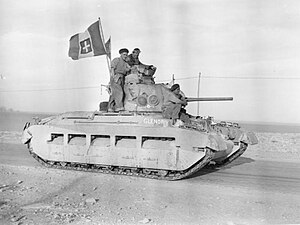Matilda II
| Infantry Tank Mark II | |
|---|---|
|
A Matilda's crew display a captured Italian flag as they enter Tobruk, January 1941
|
|
| Type | Infantry tank |
| Place of origin | United Kingdom |
| Service history | |
| In service | 1939–1945 |
| Used by | United Kingdom Australia Soviet Union |
| Wars | Second World War |
| Production history | |
| Designer | Mechanization Board and Messrs Vulcan |
| Designed | 1937 |
| Manufacturer | Vulcan Foundry and others |
| Produced | 1937–1943 |
| No. built | 2,987 |
| Variants | see Variants below |
| Specifications | |
| Weight | 25 tons |
| Length | 15 ft 11 in (4.9 m) |
| Width | 8 ft 6 in (2.6 m) |
| Height | 8 ft 3 in (2.5 m) |
| Crew | 4 (driver, gunner, loader, commander) |
|
|
|
| Armour | 20 to 78 mm/3.07in max |
|
Main
armament |
2 pounder (40 mm), 93 armour-piercing rounds |
|
Secondary
armament |
7.92 mm Besa machine gun 2,925 rounds |
| Engine | 2×diesel 6-cylinder 7 litre engines: 2×AEC or 2×Leyland 2×94–95 bhp |
| Power/weight | 7.5 bhp (5.6 kW) / tonne |
| Transmission | Wilson epicyclic pre-selector gearbox, 6 speeds |
| Suspension | Coil spring |
|
Operational
range |
160 miles (257 km) |
| Speed | 16 miles per hour (26 km/h) (on road) 9 miles per hour (14 km/h) (off road) |
|
Steering
system |
Rackham clutch |
The Infantry Tank Mark II, best known as the Matilda, was a British infantry tank of the Second World War.
The design began as the A12 specification in 1936, as a gun-armed counterpart to the first British infantry tank, the machine gun armed, two-man A11 Infantry Tank Mark I. The Mark I was also known as Matilda, and the larger A12 was initially known as the Matilda II, Matilda senior or Waltzing Matilda. The Mark I was abandoned in 1940, and from then on the A12 was almost always known simply as "the Matilda".
With its heavy armour, the Matilda II was an excellent infantry support tank but with somewhat limited speed and armament. It was the only British tank to serve from the start of the war to its end, although it is particularly associated with the North Africa Campaign. It was replaced in front-line service by the lighter and less costly Infantry Tank Mk III Valentine beginning in late 1941.
The split between the infantry tank and cruisers had its origins in the World War I division between the first British heavy tanks and the faster Whippet Medium Mark A and its successors the Medium Mark B and Medium Mark C. During the interbellum, British tank experiments generally followed these basic classifications, which were made part of the overall doctrine with the work of Major-General Percy Hobart and the influence of Captain B.H. Liddell Hart.
In 1934 Hobart, the then "Inspector, Royal Tank Corps", postulated in a paper two alternatives for a tank to support the infantry. One was a very small, heavily armoured, machine gun-armed model that would be fielded in large numbers to overwhelm the enemy defences. The other was a larger vehicle with a cannon as well as machine guns and heavier armour proof against enemy field artillery. Vickers designed a tank to a General Staff specification based on the first option as the A11 Matilda. Within the limitations of military finances, the Master-General of the Ordnance, Hugh Elles, went for the smaller machine gun tank and the larger cannon-armed version did not proceed. This requirement was passed to Vickers-Armstrongs which had a prototype (A11E1) but with armour proof against current anti-tanks guns ready by September 1936.
...
Wikipedia

